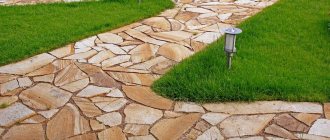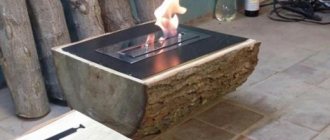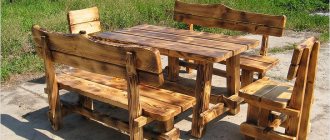There are many options for designing a yard.
Various compositions are created from what would previously have been thrown away - things and objects that have served their purpose...
If you have accumulated old tires, then do not rush to throw them away - you can use them to make a path in your garden, vegetable garden or dacha.
If you approach this process creatively, you can not only beautifully decorate the territory, but also secure it .
There are several popular ways to arrange your site, which will be discussed further.
Advantages and disadvantages of tire tracks
Many owners of country houses prefer to improve the territory themselves. In particular, this applies to travel routes and parking lots. The ideal material for their creation would be tires that are subject to recycling.
Waste tires become acceptable material for garden paths
This option does not require any special financial costs. But there are other positive aspects of using tires:
- availability;
- increased resistance to the negative effects of external factors (precipitation, high and low temperatures);
- wear resistance;
- durability (does not require annual dismantling).
Rubber does not absorb moisture (even after heavy rain it dries instantly) and it is impossible to slip on it. Caring for rubber tracks is easy - just walk over them with a broom or spray them with water from a hose. Well, the most significant plus is the ease of installation.
Along with this, there are also disadvantages:
- the need for a large number of tires (even for a small path in the garden you will need several dozen tires);
- unesthetic appearance;
- low plasticity of rubber;
- the need to create a base of gravel, otherwise the rubber track will fall into the ground.
If you don’t have unnecessary tires in your garage, you can go to the nearest tire shop or ask your car enthusiast friends.
Options for tire tracks
To build paths in the country, you can use both tires with and without disks (in the form of cut strips or tiles) . In the first case, laying is carried out flat or edgewise. If the terrain is uneven, then whole tires will make a convenient ladder. Moreover, its form can be any.
In order to make even flooring for movement, rubber is taken from tires with uniform wear. It is recommended to take wheels from trucks, since they are larger and the paths will be wider.
Curbs are also made from the side of the tires.
Photo: design ideas for paths
Tires are laid in the form of a ladder, which is convenient for dachas on a hill
It is convenient to move along the path made of tires, as it does not slip
Rubber from tires can be used to make a convenient access road
The material is cut not in the form of strips, but in tiles
In places where water accumulates after rain, you can make a bridge from tires
The simplest option for a garden path is to cut a ribbon from a tire
What types of garden paths are there?
Pedestrian paths according to their purpose can be divided into transit and walking.
Transit paths are designed for movement through main areas, most often they lead from the gate to the house or serve to connect paths in the yard. For example, from the house to the summer kitchen or veranda. The width of such paths is calculated for two pedestrians who can walk together or parallel to each other. For transit paths, it is advisable to use large tires, laying them horizontally.
Walking paths are much smaller paths. For them, 50–60 cm of the width of a passenger car tire will be quite enough. For example, a path made from shredded tires can be thrown between the beds in the country house or in the garden. Then it will be easy to move around the garden even after a heavy downpour or in winter when there is ice.
Advice! Tracks consisting of different segments of car tires look very elegant, especially when laid out carefully and decorated.
Preparatory activities
Before you start laying out trails, you should plan the scope of work. It is better to sketch on paper a diagram with all the elements that complement the path:
- curbs;
- gutters;
- drainage systems;
- lanterns.
Be sure to measure the tires in order to determine the required quantity. And this will depend on the length of the path, its shape and route.
Choosing tires for garden paths
Any tires are suitable for constructing travel routes in the garden. If you want to make the paths wider, it is better to choose truck tires. If you plan to install whole tires, then select them of the same size. For the tape type of trails, you can take material of different sizes, but you still have to cut it.
Tires of the same size should be selected for the track.
It is preferable to choose “winter tires” since they are designed for low temperatures. Such tracks will last longer.
Preparation of necessary materials and tools
Prepare the tool for work in advance:
- sharp knife or jigsaw;
- shovel;
- hammer;
- hacksaw;
- roulette;
- pencil or marker;
- axe;
- nails (from 7 cm long);
- wooden pegs.
The only material needed is old tires.
The tire must be prepared first
Designing pedestrian paths in the garden
Having a clear idea of where the trail routes should go, cottage owners can begin working on the area. However, if there is no such confidence, before starting active actions they need to start drawing up a project. In the process of routing trails, their parameters should be indicated on the diagram:
- width;
- length;
- form;
- route, etc.
Also at the stage of drawing up the project, issues of using auxiliary and decorative elements are discussed:
- border;
— water drains;
- garden lanterns;
— drainage gutters and other structural items that make the path more practical, functional and safe.
Tire border
How to make a tire track with your own hands
Choose the type of garden path from car tires depending on your abilities and preferences. Let's consider the technological process of each option.
Tape
It is necessary to cut strips from tires in accordance with the required dimensions. They do this as follows:
- First, markings are applied to the tire with a marker along which they will be cut.
- Using a jigsaw or a well-sharpened knife, start cutting the rubber - separating the part with the tread (the one that came into contact with the road when the car was moving) from the side and rim. To facilitate the process, periodically moisten the knife in a solution of laundry soap or lubricate it with grease. A wedge (adjustable wrench, wooden block, pry bar) is installed behind the knife blade.
A strip is cut from a tire - The result is a rubber ring, which is cut across and a tape comes out. Having made the required number of blanks, they begin to lay out the path.
The rubber sheet is nailed to boards or bars
Depending on the width of the path, 2-4 canvases may be needed. Nail the tapes to wooden boards, leaving gaps of 1.5–2 cm and lay them on the ground.
Over time, grass will grow into the gaps left and will keep the flooring from shifting.
It is first recommended to make a base of gravel, which will serve as drainage. To prevent the path from rising, the path for laying it is slightly deepened. This option is suitable for designing passages between beds or plantings.
Stepped
An equally interesting way is to create a ladder from whole tires. This is especially true for dachas located on uneven terrain. The main thing is to securely fix the tires so that when people move on them, there is no risk of falling. You can make a staircase in one or two rows.
The descent or ascent can be made from tires
Installation is carried out as follows:
- Lay out the tires on the ground. Begin laying out from the bottom tier, gradually moving upward. After installation, each tire is carefully checked for reliability. For greater stability, it is advisable to slightly drown it in the ground.
- Sand (earth) is poured inside the tires and compacted.
- Sprinkle the finished path with gravel to prevent slipping on it in wet weather.
From rubber plates
Paths in the garden can be made from rubber slabs. These are square or rectangular pieces cut from the same rubber from tires.
Tire rubber can be cut into tiles
They are attached to a base prepared by mixing acetone and polyurethane glue. It is important to maintain proportionality when laying slabs. The same indentation should be made between the workpieces. It will look beautiful if the gaps between the tiles are filled with colored pebbles and the coating itself is painted.
Video: how to make tiles from tires
Construction of borders
The installation of the path is completed by erecting a curb made of rubber from tires. This is done not only for the sake of decoration, but also to firmly fix the flooring.
You can decorate the edges of the garden path in different ways:
- bury the tires entirely in a vertical position;
- cut rubber bands and fasten them with nails, bolts or metal staples;
- cut the tire in half and bury the resulting arcs in the ground.
To decorate the edges of the path, it is better to use truck tires
It is recommended to use imported tires, as they have softer rubber and are easy to cut with a knife. And in order to make a cross-section you need a more serious tool - metal scissors or a jigsaw.
To decorate the edge of the path, you can use the bars remaining after paving. They will also serve as a support.
Manufacturing methods
There are several options for processing tires, the choice of which depends on skills, availability of tools and preferences. For tracks, it is worth looking for winter tires that are quite resistant to temperature changes.
From whole tires
Using rubber tires, you can make a path on relief terrain. To do this, you will need to figure out the route and the amount of building materials. It is also important that the track is securely fastened to the base. The tires are laid flat on the surface and deepened into the soil layer.
By filling the recesses with turf or a sand-gravel mixture, you can form a staircase-path. To do this, the tires are laid flat, starting from the bottom of the plot and going up. This method will help to lay the material twice as fast and create a pedestrian connection between the necessary points.
You can use tires to lay out a trail alternately in two parallel rows. When wet, the side of the tire begins to slip, so it is better to be more careful if it starts to rain. Such a road can be removed at any time or parts can be swapped to change the design.
You can make a fence from whole tires. To do this you need to throw them on top of each other.
The bottom ball of auto wheels is buried in the soil layer, and the upper rows are strung on wire. Recesses in tires are made using an awl. Such fences are easy to maintain. It can be poured with water and painted in any color scheme.
Decoration
To increase the resistance of rubber to moisture, temperature changes and ultraviolet radiation, painting is recommended . When choosing paint, preference should be given to those marked KCH-136 (intended for rubber). This paint absorbs up to 97% of sunlight and creates the smoothest possible surface. Once applied, it dries within a few hours.
If painting is done at a temperature of +25 °C, the garden path can be used within 2 days.
Roll coverings
You can also improve the area using recycled rubber, but in the form of rolls that can easily be rolled out over the surface.
This track retains all the properties of rubber, while looking much more elegant . This is an elastic and reliable material that is pleasant to walk on in any weather.
It is installed under the following conditions:
- You need a base - concrete or asphalt.
- It is covered with special glue, after which the roll is carefully unrolled along the path.
The covering method is convenient if the base is already quite damaged - in this case, the rubber track will hide traces of damage .
There are many colors and sizes, so you can get confused when choosing.
This option is also more practical - installation is easier, the path looks aesthetically pleasing. But the cost of such rubber rolls will be higher.
Mistakes when creating tracks from tires
In order for the path on your personal plot to last for more than one year, you should listen to some tips:
- Do not lay out tires without first leveling and compacting the soil. Even with the apparent levelness of the ground, in the future there is a high probability of subsidence and deformation of the sidewalk.
- Tires cannot be considered an absolutely harmless material. When exposed to strong heat in the sun, it can release harmful substances. Therefore, it is recommended to cover tire tracks with protective agents.











